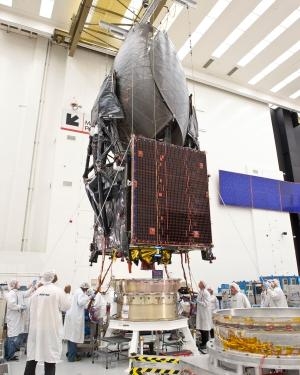Tue, Dec 25, 2012
Tracking And Data Relay Spacecraft Scheduled For Jan. 29 Launch
NASA's newest Tracking and Data Relay Satellite, known as TDRS-K, has arrived at the agency's Kennedy Space Center in Florida in preparation for launch January 29. TDRS-K arrived aboard a U.S. Air Force C-17 from the Boeing Space and Intelligence Systems assembly facility in El Segundo, CA.

For almost 30 years, the TDRS spacecraft have provided a reliable communications network for NASA, serving numerous national and international space missions. The TDRS fleet is a space-based communication system used to provide tracking, telemetry, command, and high bandwidth data return services. The satellites provide in-flight communications with spacecraft operating in low-Earth orbit. It has been 10 years since NASA's last TDRS launch. "This launch will provide even greater capabilities to a network that has become key to enabling many of NASA's scientific discoveries," says Jeffrey Gramling, project manager for TDRS at NASA's Goddard Space Flight Center in Greenbelt, MD.
TDRS-K will launch to geostationary orbit aboard an Atlas V rocket. The spacecraft is the first of three next-generation satellites designed to ensure vital operational continuity for NASA by expanding the lifespan of the fleet. The launch of TDRS-L is scheduled for 2014 and TDRS-M in 2015. Each of the new satellites has a higher performance solar panel design to provide more spacecraft power. This upgrade will return signal processing for the S-Band multiple access service to the ground -- the same as the first-generation TDRS spacecraft. Ground-based processing allows TDRS to service more customers with different and evolving communication requirements.

The TDRS fleet began operating during the space shuttle era and provides critical communication support from several locations in geostationary orbit to NASA's human spaceflight endeavors, including the International Space Station. The fleet also provides communications support to an array of science missions, as well as various types of launch vehicles. Of the nine TDRS satellites launched, seven are still operational, although four are already beyond their design life. Two have been retired. The second TDRS was lost in 1986 during the space shuttle Challenger accident.
NASA's Space Communications and Navigation Program, part of the Human Exploration and Operations Mission Directorate at the agency's Headquarters in Washington, is responsible for the TDRS network. NASA's Launch Services Program at Kennedy is responsible for launch management. United Launch Alliance provides the Atlas V rocket launch service.
(TDRS-K satellite image provided by NASA)
More News
With Testing Soon Complete, Launch Preparations Begin in Earnest Sierra Space's Dream Chaser has been put through the wringer at NASA's Glenn Armstrong Test Facility in Ohio, but w>[...]
Takeoff Roll The process whereby an aircraft is aligned with the runway centerline and the aircraft is moving with the intent to take off. For helicopters, this pertains to the act>[...]
“We’re proud of the hard work that went into receiving this validation, and it will be a welcome relief to our customers in the European Union. We couldn’t be mor>[...]
"Aircraft Spruce is pleased to announce the acquisition of the parts distribution operations of Wag-Aero. Wag-Aero was founded in the 1960’s by Dick and Bobbie Wagner in the >[...]
IDENT Feature The special feature in the Air Traffic Control Radar Beacon System (ATCRBS) equipment. It is used to immediately distinguish one displayed beacon target from other be>[...]
 Sierra Space Repositions Dream Chaser for First Mission
Sierra Space Repositions Dream Chaser for First Mission ANN's Daily Aero-Term (05.10.24): Takeoff Roll
ANN's Daily Aero-Term (05.10.24): Takeoff Roll Aero-News: Quote of the Day (05.10.24)
Aero-News: Quote of the Day (05.10.24) Aero-News: Quote of the Day (05.11.24)
Aero-News: Quote of the Day (05.11.24) ANN's Daily Aero-Term (05.11.24): IDENT Feature
ANN's Daily Aero-Term (05.11.24): IDENT Feature




